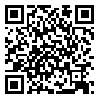دوره 9، شماره 2 - ( 10-1402 )
جلد 9 شماره 2 صفحات 144-137 |
برگشت به فهرست نسخه ها
Download citation:
BibTeX | RIS | EndNote | Medlars | ProCite | Reference Manager | RefWorks
Send citation to:



BibTeX | RIS | EndNote | Medlars | ProCite | Reference Manager | RefWorks
Send citation to:
Nasrabadi A N, Joolaee S, Navab E, Esmaeili M, Khalilabad T H, Shali M et al . Investigating the Use of White Lies During COVID-19 Pandemic: A Qualitative Study. Health in Emergencies and Disasters Quarterly 2024; 9 (2) :137-144
URL: http://hdq.uswr.ac.ir/article-1-536-fa.html
URL: http://hdq.uswr.ac.ir/article-1-536-fa.html
Investigating the Use of White Lies During COVID-19 Pandemic: A Qualitative Study. فصلنامه سلامت در حوادث و بلایا. 1402; 9 (2) :137-144
چکیده: (2812 مشاهده)
Background: While dishonesty is considered unethical, its occurrence within the healthcare system is not rare; therefore, addressing and controlling this behavior requires targeted interventions to address its root causes. This study investigates the encounters of patients with COVID-19, their families, and healthcare workers with white lies during the COVID-19 pandemic in Iran.
Materials and Methods: In this qualitative study, we employed a content analysis approach. Semi-structured interviews were conducted with 50 participants, including healthcare workers, individuals diagnosed with COVID-19, and their families. The research was carried out at teaching hospitals affiliated with the Tehran University of Medical Sciences in 2020. For data analysis, the methodology proposed by Graneheim and Lundman was used. In addition, the management and analysis of data were facilitated through MAXQDA software, version 12.
Results: This study included 23 female and 27 male participants, with a mean age of 35±6.3 years. Through data analysis, a total of 3201 codes were identified and subsequently organized into 5 main categories as follows: social stigma, media inconsistencies, fear and uncertainty, negligence, and breaking free from quarantine. These categories further branched into 11 sub-categories.
Conclusion: Employing white lies as a means to sidestep social stigma and discrimination, along with grappling with fear and xenophobia, emerged as prevalent experiences. The articulation of transparent and truthful information at the community level plays a crucial role in priming public perceptions to acknowledge factual circumstances. To achieve this, healthcare authorities and the media bear the responsibility of disseminating coherent and honest information, thereby mitigating and managing the proliferation of rumors within the community amidst the ongoing pandemic.
Materials and Methods: In this qualitative study, we employed a content analysis approach. Semi-structured interviews were conducted with 50 participants, including healthcare workers, individuals diagnosed with COVID-19, and their families. The research was carried out at teaching hospitals affiliated with the Tehran University of Medical Sciences in 2020. For data analysis, the methodology proposed by Graneheim and Lundman was used. In addition, the management and analysis of data were facilitated through MAXQDA software, version 12.
Results: This study included 23 female and 27 male participants, with a mean age of 35±6.3 years. Through data analysis, a total of 3201 codes were identified and subsequently organized into 5 main categories as follows: social stigma, media inconsistencies, fear and uncertainty, negligence, and breaking free from quarantine. These categories further branched into 11 sub-categories.
Conclusion: Employing white lies as a means to sidestep social stigma and discrimination, along with grappling with fear and xenophobia, emerged as prevalent experiences. The articulation of transparent and truthful information at the community level plays a crucial role in priming public perceptions to acknowledge factual circumstances. To achieve this, healthcare authorities and the media bear the responsibility of disseminating coherent and honest information, thereby mitigating and managing the proliferation of rumors within the community amidst the ongoing pandemic.
| بازنشر اطلاعات | |
 |
این مقاله تحت شرایط Creative Commons Attribution-NonCommercial 4.0 International License قابل بازنشر است. |





